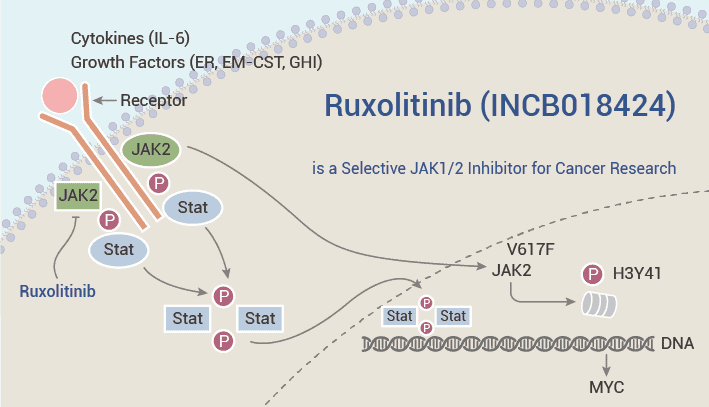JAK (Janus kinase) is a family of intracellular, non-receptor tyrosine kinases that transduce cytokine-mediated signals via the JAK-STAT pathway. Particularly, JAK2 is a member of the JAK family of cytoplasmic tyrosine kinases, which also include JAK1, JAK3, and TYK2. Importantly, the study shows that JAK1 and JAK2 may interact, resulting in their transactivation. In addition, Immune cell activation in general and particularly during rheumatoid arthritis progression requires signaling by Janus kinases (JAK1, JAK2, JAK3).
Ruxolitinib (INCB018424) is a potent, selective, and orally active JAK1/2 inhibitor.

Ruxolitinib shows selective for JAK1/2 with IC50 values of 3.3, 2.8, 428, 19, >1000, >10000 nM for JAK1, JAK2, JAK3, Tyk2, CHK2, cMET, respectively. Besides, Ruxolitinib (0-2000 nM; 2.5 h) inhibits the expression of p-JAK2, pstat5, pERK1/2, and p-STAT3 protein levels in a dose-dependent manner in Ba/F3 and HEL cells. In addition, Ruxolitinib (0-1000 nM; 24 h) induces apoptosis in a dose-dependent manner in Ba/F3-EpoR-JAK2V617F cells. Moreover, Ruxolitinib inhibits hematopoietic progenitor cell proliferation in primary MPN patient samples with the IC50 values of 407, 223 nM for normal donors erythroid progenitors and PV donors erythroid progenitors, respectively.
Ruxolitinib also shows anti-cancer activity in mice. Ruxolitinib (180 mg/kg; orally, twice a day for 2 weeks) results in a survival rate of greater than 90% by day 22 and markedly reduces splenomegaly and circulating levels of inflammatory cytokines, and preferentially eliminated neoplastic cells, resulting in significantly prolonged survival without myelosuppressive or immunosuppressive effects in a JAK2V617F-driven mouse mode. Additionally, Ruxolitinib significantly suppresses IL-6 levels and reduces TNF-α levels in the Ba/F3-EpoR-JAK2V617F model.
All in all, Ruxolitinib is a potent, selective and orally active JAK1/2 inhibitor. Ruxolitinib has the potential for the research of myeloproliferative neoplasm (MPN).
Reference:
[1] Quintás-Cardama A, et al. Blood. 2010 Apr 15;115(15):3109-17.
[2] Tavallai M, et al. Front Oncol. 2016 Jun 13;6:142.